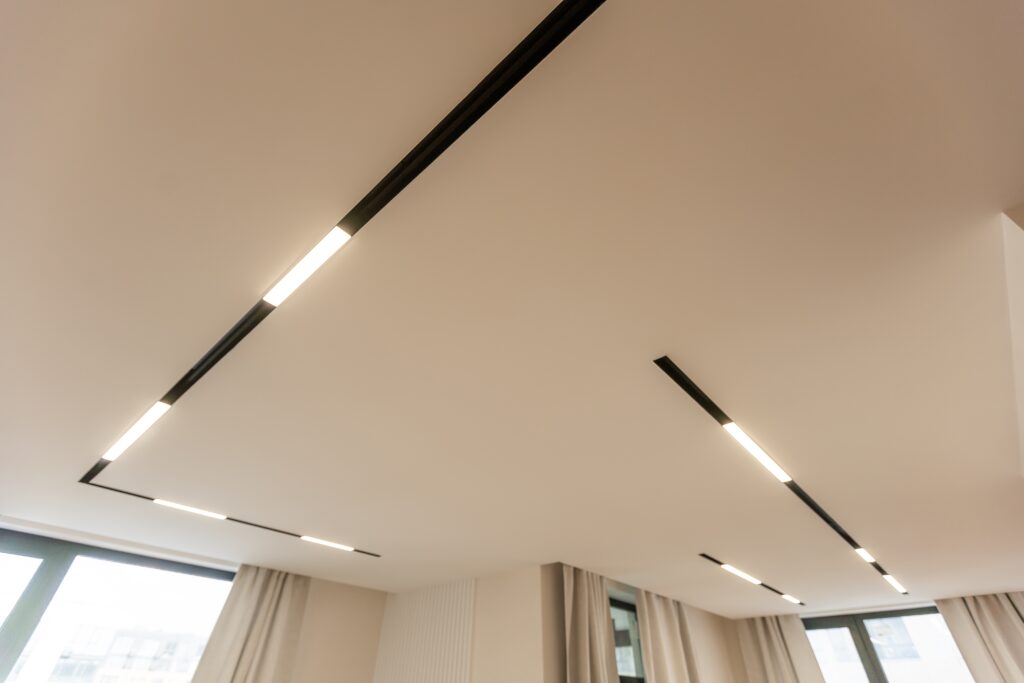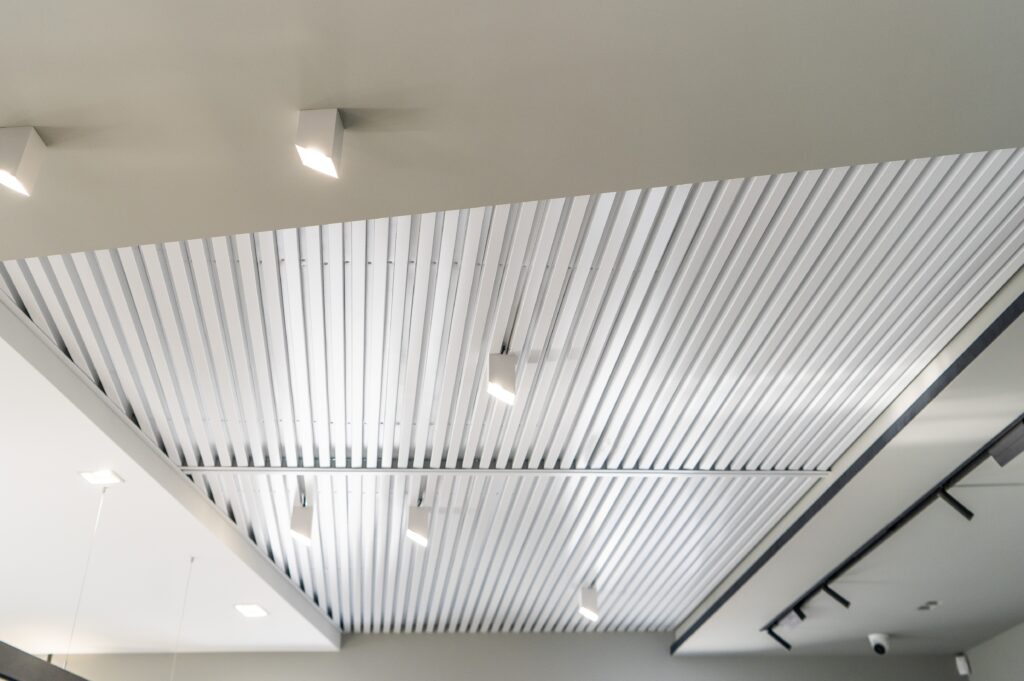LED vs. Fluorescent: Which is the Best Choice for You?
Many businesses are now weighing the switch from fluorescent to LED lighting for better efficiency. Choosing the right lighting is essential for businesses because it impacts everything from energy bills to employee comfort. Lighting alone accounts for roughly 11% of electricity use in commercial buildings, so making an informed choice between LED and fluorescent can significantly affect operating costs and sustainability. In this blog, we’ll explore how LED and fluorescent lighting compare across energy efficiency, lifespan, light quality, environmental impact, and costs, helping you determine the best choice for your business needs.
Energy Efficiency Comparison
When it comes to energy consumption, LED lighting consistently outperforms fluorescent lighting. Modern LEDs can be 18–44% more efficient than typical fluorescent tubes, and U.S. Department of Energy findings show LED systems are about 25% more energy-efficient on average than fluorescents. In practical terms, this means LEDs provide the same brightness using significantly fewer watts – businesses that upgrade from fluorescent to LED often see around a 30% reduction in lighting electricity usage. Over time, those efficiency gains translate into noticeably lower monthly electricity bills.
Lifespan and Maintenance
Another major difference is how long the lights last and what maintenance they require. LED lights have an exceptionally long lifespan – often 50,000 hours or more – whereas fluorescent lamps typically last only around 10,000 hours before burning out. This means an LED can run for many years (even with heavy daily use) before needing replacement, outlasting fluorescents several times over. Fewer burnout cycles also lead to far lower maintenance costs: facilities spend less time and money changing bulbs and fixing fixtures. In fact, when retrofitting fluorescents to LED, the old ballast can usually be removed or bypassed, eliminating a common point of failure. The extended lifespan and minimal upkeep of LEDs can save businesses substantial labor and replacement costs over the long run.
Light Quality and Performance
The quality of light from LEDs versus fluorescents also differs significantly. LEDs provide bright, consistent illumination without the flickering that often plagues aging fluorescent tubes. They turn on at full brightness instantly (no warm-up period), and most are easily dimmable, allowing better control over lighting levels. In terms of color quality, LED technology can produce a wide range of color temperatures (from warm yellow-white to cool daylight) and generally offers high color rendering, helping objects and spaces look more natural. Fluorescent lights, by contrast, sometimes flicker or hum (especially as bulbs or ballasts wear out) and offer a more limited selection of color temperatures per bulb. In an office or retail environment, the comfortable, stable light of LEDs can enhance employee productivity and customer experience, whereas fluorescent lighting may cause eye strain or fatigue over time.

Environmental Impact
Sustainability is a crucial factor when comparing LED vs. fluorescent lighting. LEDs are a clear winner here, primarily because they contain no mercury, while fluorescent lamps rely on mercury vapor to produce light. Each fluorescent tube carries a small amount of mercury that becomes hazardous waste when the bulb is disposed of. Unfortunately, an estimated 75% of fluorescent bulbs in the U.S. are not recycled or disposed of properly – meaning much of that toxic mercury ends up in landfills and can leach into soil and water. By switching to mercury-free LEDs, businesses eliminate this pollution risk and avoid handling hazardous materials.
LEDs also help reduce carbon emissions. Their superior energy efficiency means less electricity is needed, which in turn means lower CO2 emissions from power plants. In fact, a complete transition from fluorescent to LED lighting in the U.S. could cut annual carbon dioxide emissions by the equivalent of removing 4 million cars from the road. Beyond cutting energy use, the longer lifespan of LEDs means fewer bulbs go to the landfill over time. Overall, LED lighting offers a far more sustainable and eco-friendly profile than fluorescent, from operation to disposal.
Installation and Upfront Costs
Cost is often a deciding factor when upgrading lighting. Fluorescent fixtures and tubes usually have a lower purchase price than LED equivalents, but this upfront gap has been shrinking in recent years. LEDs do require a higher initial investment per bulb or fixture, yet businesses find that the energy and maintenance savings quickly pay back that difference – often within a couple of years. In terms of installation, switching from fluorescent to LED is typically straightforward, especially with retrofit kits and LED tube replacements. Many LED tubes are designed to fit into existing fluorescent fixtures with minor wiring adjustments (for example, bypassing or removing the old ballast). This means you can often upgrade to LEDs without a full overhaul of your lighting system. While the upfront cost for LEDs is higher, the ease of retrofitting and the long-term financial benefits make it a smart investment for most facilities.
Rebates and Incentives
To further tip the scales in favor of LEDs, there are many rebates and incentives available. Electric utilities in many regions offer substantial rebates for businesses that convert to energy-efficient LED lighting – often covering 35% to 50% of the project cost as a reward for reducing grid demand. Additionally, government programs provide tax incentives for upgrading to greener lighting. In the U.S., for example, the IRS offers an energy-efficiency deduction worth $0.60 per square foot for LED lighting upgrades in commercial buildings. Taken together, these rebates and tax breaks can significantly lower the effective cost of an LED retrofit. They improve the return on investment and make switching to LEDs even more affordable for businesses. Be sure to check what local utility programs or federal incentives apply in your area – taking advantage of these can help offset the initial expense of LED installation.

Comparison Table
Below is a quick side-by-side comparison of LED vs. fluorescent lighting on key factors:
| Factor | LED Lighting | Fluorescent Lighting |
| Energy Efficiency | Very high – uses significantly less wattage for the same light output, cutting energy bills. | Moderate – uses more power for equivalent brightness, leading to higher energy costs. |
| Lifespan | 50,000+ hour typical lifespan (several years of continuous use) before dimming or failure. | ~10,000 hour typical lifespan; bulbs need frequent replacement (every 1-2 years in many cases). |
| Maintenance | Low – infrequent replacements needed; no ballasts required (fewer points of failure). | High – regular bulb and ballast replacements add maintenance labor and cost. |
| Light Quality | Instant full brightness, no flicker or hum; available in many color temperatures with high color accuracy (CRI). | May flicker or buzz as they age; limited color temperature options per bulb; light output can degrade over time. |
| Environmental Impact | No hazardous materials (mercury-free); lower CO2 footprint due to energy savings; less waste thanks to long life. | Contains mercury (requires special disposal); higher energy use means more CO2 emissions; burnt-out tubes add to waste stream. |
| Upfront Cost | Higher initial cost per fixture or bulb (though prices are falling each year). | Lower initial cost per bulb/fixture. |
| Long-Term Cost | Very low – pays off over time through energy and maintenance savings; often the most cost-effective choice long-term. | Higher – ongoing energy use and replacements make total cost of ownership much greater over the fixture’s life. |
Which One is Right for You?
So, LED or fluorescent – which lighting is the best fit for your business? The answer will depend on your priorities, but for most businesses LED lighting comes out on top. If your goal is long-term cost savings, energy efficiency, and minimal maintenance, LEDs are the clear winner. They excel in high-use environments (like offices, warehouses, or retail stores) where lights might be on for 8+ hours a day – in these scenarios, the electricity savings and reduced replacement needs are tremendous. Fluorescent lighting might appeal if you have a very tight upfront budget or need a quick fix, as the bulbs themselves cost less initially. However, you’ll pay more in the long run through higher energy bills and frequent replacements. It’s also worth considering that fluorescent tubes are gradually being phased out in favor of LED technology due to environmental regulations and efficiency standards. In fact, industry experts note that LEDs have “changed the game,” leaving “no good reason to keep using fluorescents” now that LED options are widely available.
In short, an LED solution is usually the best choice for companies looking to improve lighting quality and reduce costs over time. Every facility is different, though – factors like the size of your space, hours of operation, and existing equipment can influence the decision. To make the right choice, it can help to consult with commercial lighting experts. They can assess your current setup and recommend the optimal lighting strategy for your specific needs. Often, businesses find that the benefits of switching to LED far outweigh any drawbacks, especially once available rebates and incentives are factored in.
Why Now is the Best Time to Upgrade to LED Lighting
In the LED vs. fluorescent debate, LEDs offer clear advantages for most business applications – from drastically lower energy consumption and longer life, to superior light quality and environmental safety. Fluorescent lighting had its era as an efficient solution, but modern LED technology has surpassed it on virtually every front. By switching to LED, companies can save money, improve their workplace lighting conditions, and contribute to a greener planet.
Ready to make the switch? Upgrading your facility’s lighting can seem daunting, but it doesn’t have to be. Sunbright LED Systems LLC offers a free lighting survey and energy audit to evaluate your current setup and identify the ideal upgrade path. Our team will help you quantify the potential savings and find any available rebates, making it easy to move forward. Contact Sunbright LED Systems today to schedule your free lighting audit and let us help you transform your business with energy-efficient LED lighting.

Frequently Asked Questions (FAQs)
How much can my business save by switching to LED lighting?
Businesses typically save 30–50% on lighting energy costs, with some achieving up to 70% savings. This can translate to thousands of dollars annually.
Are LEDs more expensive upfront than fluorescent lighting?
Yes, LEDs have a higher upfront cost, but they pay for themselves within 12–18 months through lower energy bills and maintenance savings.
Can LEDs work with my existing fluorescent fixtures?
Yes, many LED retrofit options are designed to fit into existing fixtures with minimal adjustments. Ballast-bypass LED tubes are a common solution.
What rebates and incentives are available for LED upgrades?
Utility rebates typically cover 35–50% of project costs, and federal tax deductions of $0.60 per square foot may also apply.
How long do LEDs last compared to fluorescent lights?
LEDs last 50,000+ hours (10+ years), while fluorescents last around 10,000 hours (1–2 years). This means fewer replacements and lower maintenance costs.
